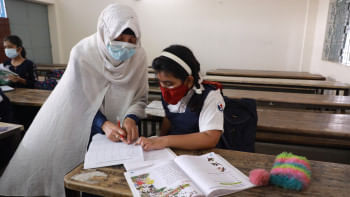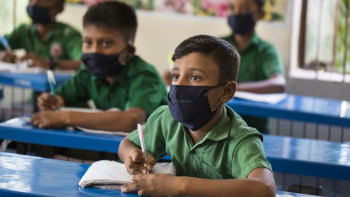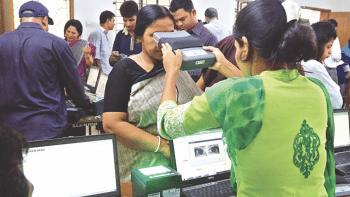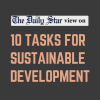Growing rural-urban education divide is hurting Bangladesh's future

Education is the cornerstone upon which a nation's prosperity and progress are built. We can work on health, infrastructure and finance, but if we do not improve a country's human capital through education, no other initiatives will succeed. In the 2023 Secondary School Certificate (SSC) examination, 48 schools witnessed a zero percent pass rate. Of them, most schools are situated in rural areas. Even the zilla schools, which are well-reputed for their quality of education, are losing their glory day by day. Rural or non-urban students are no less geniuses, so what is impeding them to shine?
The Bangladesh Education Fact Sheets 2020 shows that the majority of children who do not acquire skills live in rural areas, with 81 percent of them not acquiring numeracy skills and 82 percent not acquiring reading skills. According to the report, children from rural areas make up 80 percent of dropouts and 74 percent of repeaters. Furthermore, 80 percent of children who do not complete primary or secondary education live in rural areas, exceeding the national average of the rural population.
The situation is bleak for tertiary education as well. Several tracer studies of graduates from universities, colleges, and polytechnics revealed that 66 percent of university students hail from metropolitan, urban and semi-urban areas, and only 34 percent belong to rural areas. As almost 70 percent of our schooling population comes from rural areas, this data clearly shows that most of the rural-origin students are not reaching university. The road to job-relevant technical and higher education remains mostly unreached to rural students. In a nutshell, the precious lives of rural students are fading in a barren desert of disparity.
The rural-urban education divide can perpetuate inequality and hinder the overall development of a country or region. Economic inequality is unavoidable in the early days of development, but this divide is negative to development. According to Bangladesh Education Statistics 2022, more than 76 percent of educational institutions are situated in rural areas. Therefore, if we do not ensure the quality of rural students and institutions, the dream to achieve holistic educational quality and inclusive development will remain unfulfilled.
Digging into the gap
To understand the drivers behind the disparity in education, the issue of teacher quality must be considered first. High-quality teachers are essential for providing quality education to students, as research confirms. However, the shortage of qualified and trained teachers is a national problem. Where the percentage of total trained teachers is 100 percent in Bhutan, Philippines and Thailand, 97 percent in Nepal, 95 percent in Myanmar and 89 percent in India, it is only 74 percent in Bangladesh. Again, the quality is questionable. This situation is more complicated in rural areas. Attracting and retaining skilled educators in rural locations is difficult, affecting the quality of education.
The system of bringing educational institutions under MPO (monthly pay order) is becoming a curse in disguise in many cases. It is burying the quest for excellence in rural or local schools that drove them to improve their performances. Many rural schools also suffer from teacher absenteeism. The politicisation of school committees and the absence of local ownership are worsening the situation. As a result, village factionalism has cropped up and school management has weakened, marring the quality of the academic environment.
Like many other sectors, we have made development an infrastructure game in the education sector. We are counting the number of primary schools. Nevertheless, we have to keep in mind that it is not about infrastructure or number of teachers or students. It is quality that matters. There are schools in many places where there is no enrolment at all. This development serves absolutely no purpose. We need to stop counting schools as an indicator of development and shift our focus towards ensuring high-quality education.
Unsupervised use of digital media and technology is harming rural students severely. It affects urban students nonetheless, but the ability and awareness of urban parents to supervise offsets the detrimental effects of poor use of technology, which is not the case for rural students. Due to this alarming situation, many students are distracted from their studies.
It is imperative that proper solutions be devised to reduce the rural-urban education inequality. Policymakers, educators, community leaders, and stakeholders need to collaborate earnestly in implementing solutions that bridge this gap and pave the way for a more inclusive future for generations to come.
Girls are doing well, but early marriage is causing a high rate of dropout. In Bangladesh, 59 percent of women have been married before the age of 18. Rural areas have a high prevalence of child marriage, which is linked to adverse outcomes including maternal and child mortality. It often leads to early childbearing, which negatively affects girls' education, as they are more likely to drop out of school. These girls have high potential and could make a great contribution to the workforce. But they are getting lost in the abyss, far from the light of education.
The rapid changes and experiments in school curricula pose another set of problems. Many sincere teachers developed teaching materials through their experience and hard work, which are now obsolete. Given the base quality difference, rural teachers will face more problems. They need extensive support and continuous training to get accustomed to the new curriculum.
The socioeconomic conditions in rural areas deepen this divide. It is difficult to focus on studies when you do not have food for the next meal at home. Poverty also impedes cognitive function. A feeling of uncertainty and anxiety stems from poverty, which does not let children from poor families strive. Consequently, many students drop out of school in rural areas. Those who do not drop out are also affected. Many are involved in child labour. According to Bangladesh Education Fact Sheets 2020, the rates of child labour are higher in rural areas but fall below the national average in urban areas. Even if students are at school or not involved in child labour, they suffer due to a lack of access to educational resources.
Despite the hope that the new curriculum, being practical-oriented and creative, will have a positive effect, there remains a possibility that it could exacerbate the existing divide. The curriculum's demand for educational materials and supplies may exceed the financial capabilities of numerous impoverished rural families, potentially leading to increased dropout rates or academic challenges among students.
In this situation, it is imperative that proper solutions be devised to reduce the rural-urban education inequality. Policymakers, educators, community leaders, and stakeholders need to collaborate earnestly in implementing solutions that bridge this gap and pave the way for a more inclusive future for generations to come.
Dr Mohammad Tareque is director at the Bangladesh Institute of Governance and Management (BIGM), former finance secretary, and former alternative executive director at the World Bank.
Tasfia Tasneem Ahmed is research associate at the BIGM.
Views expressed in this article are the authors' own.
Follow The Daily Star Opinion on Facebook for the latest opinions, commentaries and analyses by experts and professionals. To contribute your article or letter to The Daily Star Opinion, see our guidelines for submission.


 For all latest news, follow The Daily Star's Google News channel.
For all latest news, follow The Daily Star's Google News channel. 











Comments